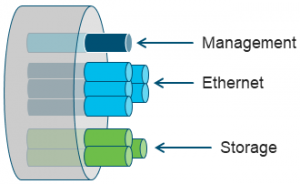I’ve been working on Cisco UCS TCO/ROI for almost 12 years. The results have remained remarkably consistent, and I’d like to share what I’ve learned over the last decade plus.
Spend money to save money
Before I get into some UCS specifics, I wanted to talk about modernization / refresh. I wrote about the non-monetary reasons in my blog Choosing to modernize your infrastructure isn’t just about TCO so let’s talk money here.
You can choose either a CapEx or OpEx model when buying Cisco UCS. CapEx is straight forward. From an OpEx perspective, you can choose a lease from Cisco Capital or your own financing. You might choose Cisco+, a consumption payment model offering maximum flexibility.
Regardless of how you choose to procure your new servers, with faster 3rd Gen Intel® Xeon® Scalable processors, a large memory footprint, and fast NVMe storage, even though there is an outlay, server consolidation can pay for itself. What the ratio will be is heavily dependent upon what you’re coming from and the new server configuration. 3:1, 4:1, or 5:1 are all within the realm of possibility. What does server consolidation get you besides a more reliable infrastructure? The biggest savings should come from software licensees and maintenance. Let’s do some simple math.  You have 100 2S servers and paid $1,000 per socket for a piece of software and are paying $500/year/socket for maintenance. For your current environment, you’ll spend $300,000 in software maintenance (100 servers * two CPUs * $500 * 3-years) over the next three years. Using the least favorable ratio of 3:1, you’ll buy 34 new servers. For that same software, you’ll spend $170,000 over the next three years ((34 servers * two CPUs * $1,000) + (34 servers * two CPUs * $500 * 3-years)). That’s $130,000 towards the investment in new, more reliable servers. At 4:1, that savings jumps to $175,000, etc. More servers or more applications mean bigger savings. Now add-in significant power & cooling savings and day 2 operations because of fewer servers.
You have 100 2S servers and paid $1,000 per socket for a piece of software and are paying $500/year/socket for maintenance. For your current environment, you’ll spend $300,000 in software maintenance (100 servers * two CPUs * $500 * 3-years) over the next three years. Using the least favorable ratio of 3:1, you’ll buy 34 new servers. For that same software, you’ll spend $170,000 over the next three years ((34 servers * two CPUs * $1,000) + (34 servers * two CPUs * $500 * 3-years)). That’s $130,000 towards the investment in new, more reliable servers. At 4:1, that savings jumps to $175,000, etc. More servers or more applications mean bigger savings. Now add-in significant power & cooling savings and day 2 operations because of fewer servers.
Unified Fabric
This is the first of UCS’ true differentiators. Using our Virtual Interface Cards (VICs – a NIC on steroids), we have the industry’s only single-wire solution for data/storage/management traffic with a single adapter. When paired with our Fabric Interconnects, it allows you to greatly simplify your cable plant and switching infrastructure. This has a direct impact on the cost of an UCS X-Series solution.
CapEx
Unified fabric means UCS X210c Compute Nodes don’t need Fibre Channel adapters and the UCS X9508 Modular Chassis doesn’t need intra-chassis Fibre Channel switches to support SAN storage access. Additionally, the 6400 Series Fabric Interconnects take the place of Fibre Channel edge switching. Fewer adaptors, cables, and switches lowers the CapEx cost of the solution. Cisco customers, in published case studies, reported an average reduction in cabling of 78% and cost savings of 68% after switching to Cisco’s unified fabric.
Besides not having Fibre Channel switching, the UCS X9508 chassis is missing a lot of things. While it does have Intelligent Fabric Modules (IFMs) in place of intra-chassis Ethernet switches, it doesn’t have any embedded management appliances, interconnect modules, or chassis specific software which add cost. And the warranty (Smart Net) is simpler and generally less expensive – one amount for the entire chassis. You don’t have additional warranty costs for other chassis components. Don’t forget to include the server warranty cost when evaluating the total cost of the solution; the results may surprise you.
Power & cooling
I discussed the UCS X-Series specific power and cooling improvements in the The power of innovation– Cisco UCS X9508 Chassis blog. Let me add some additional insights here. Unified fabric, as discussed above, eliminates hardware. That means there are fewer devices to power and cool. Server consolidation will also provide savings by eliminating even more hardware. Before the introduction of X-Series, our case studies showed that UCS customers were seeing an average reduction in power and cooling costs of 52% after updating their current infrastructure to a UCS solution. With the power delivery efficiencies of X-Series, I hope to see that number improve.
Administration & management
 This is UCS’s superpower. Instead of being redundant to my Modernize Everything – Cisco UCS X-Series and Cisco Intersight blog, let me give some cost savings statistics based again on those case studies.
This is UCS’s superpower. Instead of being redundant to my Modernize Everything – Cisco UCS X-Series and Cisco Intersight blog, let me give some cost savings statistics based again on those case studies.
With our pools, policies, and profile server deployment, customers had an average reduction of 85% in provisioning times. The sooner a server is in production, the sooner it is providing value. Once the server is in production, customers saw an average 62% reduction in day 2 operations costs. Combined, you now have a huge chunk of time and money to focus on strategic new initiatives, service improvements, and more mission critical tasks.
How much can UCS X-Series save you?
Good question. I would encourage you to talk with your Cisco account team or partner and delve into the TCO. Even better, Cisco is currently offering different incentives to help you in your transition. These can provide significant additional savings.
What’s next
Come back next week and we’ll recap the whole blog series. Can’t wait until then, check out the links in the blog for more information on UCS X-Series.
Resources:
- Series Blog #1 – UCS X-Series Unbox the future today
- Series Blog #2 – The power of innovation – Cisco UCS X9508 Chassis
- Series Blog #3 – The power of possibilities – Cisco UCS X210c M6 Compute Node
- Series Blog #4 – UCS X-Series Intelligent Fabric Modules deliver simplicity and performance
- Series Blog #5 – X marks the spot – Cisco UCS X-Fabric Technology
- Series Blog #6 – Modernize everything – Cisco UCS X-Series & Cisco Intersight
- Series Blog #7 – Cisco UCS X-Series powers modern applications
- Series Blog #8 – The advantage of partnerships – Cisco UCS X-Series Solutions
- Series Blog #9 – Do more today, save money tomorrow with UCS X-Series
- Series Blog #10 – UCS X-Series – Computing for the next decade
CONNECT WITH US